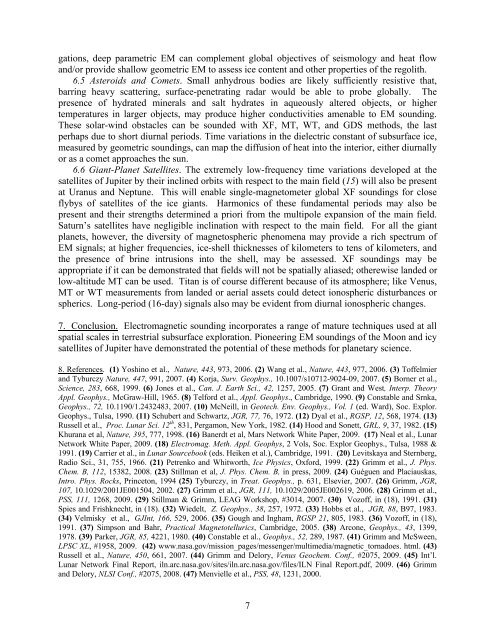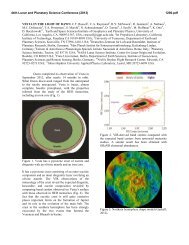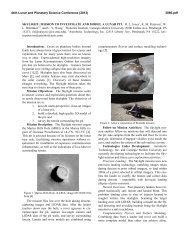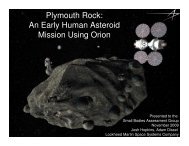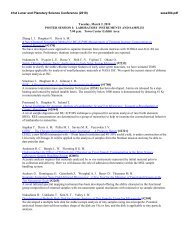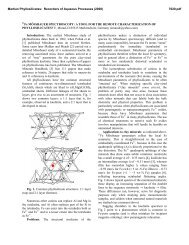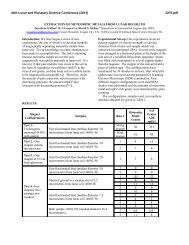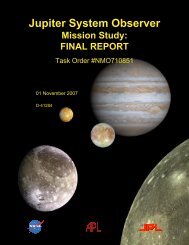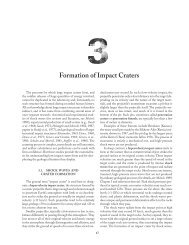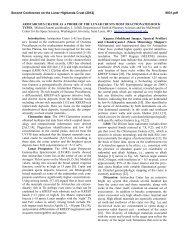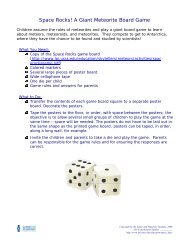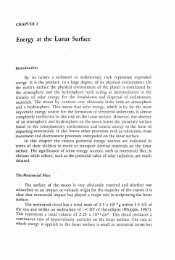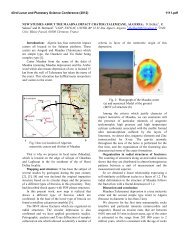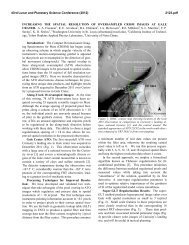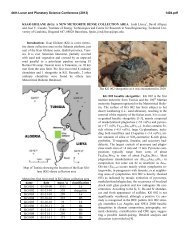Electromagnetic Sounding of Solid Planets and Satellites
Electromagnetic Sounding of Solid Planets and Satellites
Electromagnetic Sounding of Solid Planets and Satellites
Create successful ePaper yourself
Turn your PDF publications into a flip-book with our unique Google optimized e-Paper software.
gations, deep parametric EM can complement global objectives <strong>of</strong> seismology <strong>and</strong> heat flow<br />
<strong>and</strong>/or provide shallow geometric EM to assess ice content <strong>and</strong> other properties <strong>of</strong> the regolith.<br />
6.5 Asteroids <strong>and</strong> Comets. Small anhydrous bodies are likely sufficiently resistive that,<br />
barring heavy scattering, surface-penetrating radar would be able to probe globally. The<br />
presence <strong>of</strong> hydrated minerals <strong>and</strong> salt hydrates in aqueously altered objects, or higher<br />
temperatures in larger objects, may produce higher conductivities amenable to EM sounding.<br />
These solar-wind obstacles can be sounded with XF, MT, WT, <strong>and</strong> GDS methods, the last<br />
perhaps due to short diurnal periods. Time variations in the dielectric constant <strong>of</strong> subsurface ice,<br />
measured by geometric soundings, can map the diffusion <strong>of</strong> heat into the interior, either diurnally<br />
or as a comet approaches the sun.<br />
6.6 Giant-Planet <strong>Satellites</strong>. The extremely low-frequency time variations developed at the<br />
satellites <strong>of</strong> Jupiter by their inclined orbits with respect to the main field (15) will also be present<br />
at Uranus <strong>and</strong> Neptune. This will enable single-magnetometer global XF soundings for close<br />
flybys <strong>of</strong> satellites <strong>of</strong> the ice giants. Harmonics <strong>of</strong> these fundamental periods may also be<br />
present <strong>and</strong> their strengths determined a priori from the multipole expansion <strong>of</strong> the main field.<br />
Saturn’s satellites have negligible inclination with respect to the main field. For all the giant<br />
planets, however, the diversity <strong>of</strong> magnetospheric phenomena may provide a rich spectrum <strong>of</strong><br />
EM signals; at higher frequencies, ice-shell thicknesses <strong>of</strong> kilometers to tens <strong>of</strong> kilometers, <strong>and</strong><br />
the presence <strong>of</strong> brine intrusions into the shell, may be assessed. XF soundings may be<br />
appropriate if it can be demonstrated that fields will not be spatially aliased; otherewise l<strong>and</strong>ed or<br />
low-altitude MT can be used. Titan is <strong>of</strong> course different because <strong>of</strong> its atmosphere; like Venus,<br />
MT or WT measurements from l<strong>and</strong>ed or aerial assets could detect ionospheric disturbances or<br />
spherics. Long-period (16-day) signals also may be evident from diurnal ionospheric changes.<br />
7. Conclusion. <strong>Electromagnetic</strong> sounding incorporates a range <strong>of</strong> mature techniques used at all<br />
spatial scales in terrestrial subsurface exploration. Pioneering EM soundings <strong>of</strong> the Moon <strong>and</strong> icy<br />
satellites <strong>of</strong> Jupiter have demonstrated the potential <strong>of</strong> these methods for planetary science.<br />
8. References. (1) Yoshino et al., Nature, 443, 973, 2006. (2) Wang et al., Nature, 443, 977, 2006. (3) T<strong>of</strong>felmier<br />
<strong>and</strong> Tyburczy Nature, 447, 991, 2007. (4) Korja, Surv. Geophys., 10.1007/s10712-9024-09, 2007. (5) Borner et al.,<br />
Science, 283, 668, 1999. (6) Jones et al., Can. J. Earth Sci., 42, 1257, 2005. (7) Grant <strong>and</strong> West, Interp. Theory<br />
Appl. Geophys., McGraw-Hill, 1965. (8) Telford et al., Appl. Geophys., Cambridge, 1990. (9) Constable <strong>and</strong> Srnka,<br />
Geophys., 72, 10.1190/1.2432483, 2007. (10) McNeill, in Geotech. Env. Geophys., Vol. 1 (ed. Ward), Soc. Explor.<br />
Geophys., Tulsa, 1990. (11) Schubert <strong>and</strong> Schwartz, JGR, 77, 76, 1972. (12) Dyal et al., RGSP, 12, 568, 1974. (13)<br />
Russell et al., Proc. Lunar Sci. 12 th , 831, Pergamon, New York, 1982. (14) Hood <strong>and</strong> Sonett, GRL, 9, 37, 1982. (15)<br />
Khurana et al, Nature, 395, 777, 1998. (16) Banerdt et al, Mars Network White Paper, 2009. (17) Neal et al., Lunar<br />
Network White Paper, 2009. (18) Electromag. Meth. Appl. Geophys, 2 Vols, Soc. Explor Geophys., Tulsa, 1988 &<br />
1991. (19) Carrier et al., in Lunar Sourcebook (eds. Heiken et al.), Cambridge, 1991. (20) Levitskaya <strong>and</strong> Sternberg,<br />
Radio Sci., 31, 755, 1966. (21) Petrenko <strong>and</strong> Whitworth, Ice Physics, Oxford, 1999. (22) Grimm et al., J. Phys.<br />
Chem. B, 112, 15382, 2008. (23) Stillman et al, J. Phys. Chem. B, in press, 2009. (24) Guéguen <strong>and</strong> Placiauskas,<br />
Intro. Phys. Rocks, Princeton, 1994 (25) Tyburczy, in Treat. Geophys., p. 631, Elsevier, 2007. (26) Grimm, JGR,<br />
107, 10.1029/2001JE001504, 2002. (27) Grimm et al., JGR, 111, 10.1029/2005JE002619, 2006. (28) Grimm et al.,<br />
PSS, 111, 1268, 2009. (29) Stillman & Grimm, LEAG Workshop, #3014, 2007. (30) Voz<strong>of</strong>f, in (18), 1991. (31)<br />
Spies <strong>and</strong> Frishknecht, in (18). (32) Wiedelt, Z. Geophys., 38, 257, 1972. (33) Hobbs et al., JGR, 88, B97, 1983.<br />
(34) Velmisky et al., GJInt, 166, 529, 2006. (35) Gough <strong>and</strong> Ingham, RGSP 21, 805, 1983. (36) Voz<strong>of</strong>f, in (18),<br />
1991. (37) Simpson <strong>and</strong> Bahr, Practical Magnetotellurics, Cambridge, 2005. (38) Arcone, Geophys., 43, 1399,<br />
1978. (39) Parker, JGR, 85, 4221, 1980. (40) Constable et al., Geophys., 52, 289, 1987. (41) Grimm <strong>and</strong> McSween,<br />
LPSC XL, #1958, 2009. (42) www.nasa.gov/mission_pages/messenger/multimedia/magnetic_tornadoes. html. (43)<br />
Russell et al., Nature, 450, 661, 2007. (44) Grimm <strong>and</strong> Delory, Venus Geochem. Conf., #2075, 2009. (45) Int’l.<br />
Lunar Network Final Report, iln.arc.nasa.gov/sites/iln.arc.nasa.gov/files/ILN Final Report.pdf, 2009. (46) Grimm<br />
<strong>and</strong> Delory, NLSI Conf., #2075, 2008. (47) Menvielle et al., PSS, 48, 1231, 2000.<br />
7


